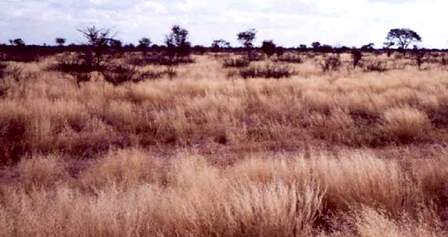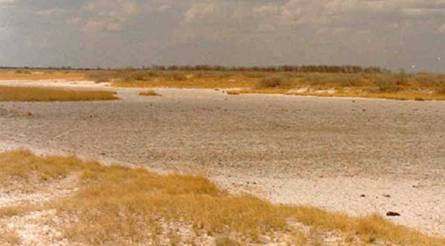Vegetation
The vegetation in the study area (both Rakops and Mopipi areas of the Boteti area) is a tree savannah which occupies the riparian zone peripheral to the length of the Boteti river. Shrub savannah is prevalent in the plains area. The southern parts of the western and eastern plains are grass savannah. Tree savannah consists of deciduous trees greater than one metre in height comprising open (5 - 15%), moderate (15 - 50%) and dense (>50%) crown cover. Typical in the area is the prevalence of Acacia erioloba, A. tortilis, A. mellifera, Boscia albitrunca. Islands of Hyphaene palms are common, as well as Adansonia digitata (Baobab) trees, either solitary or in clumps.
Shrub savannah is predominantly multiple stemmed and may branch below 1.0 m with moderate to dense crown cover with the ground usually covered by grass. Grewia flava, Rhus spp, Rhygosium bravispinosum exemplify the shrub species in the area.

Figure 4: Typical grassland savanna far from grazing pressure (J.R. Atlhopheng)

Figure 5: Patchy grassland savannah due to pans or overgrazing (J.R. Atlhopheng)
Grass savannah consists of grasses of varying densities within which the trees and shrubs cover less than 5%. The herbaceous cover density and richness tend to increase with distance away from the village or the river. Cynodon dactylon dominate the zone around 8 - 10 km from the village. Beyond this zone, palatable grasses include Anthephora pubescence, Digitaria eriantha and Schemidtia pappophoroides occur. The Makgadikgadi lacustrine system is mainly covered by grasslands with halophytic species, of which Odyssea paucinervis is dominant.
Panicum coloratum var. Makgadikgadiensis and Cenchrus ciliaris also form a major part of the grass association. Particular features are sparse savannahh grassland and high proportion of bare ground (68 - 80%).